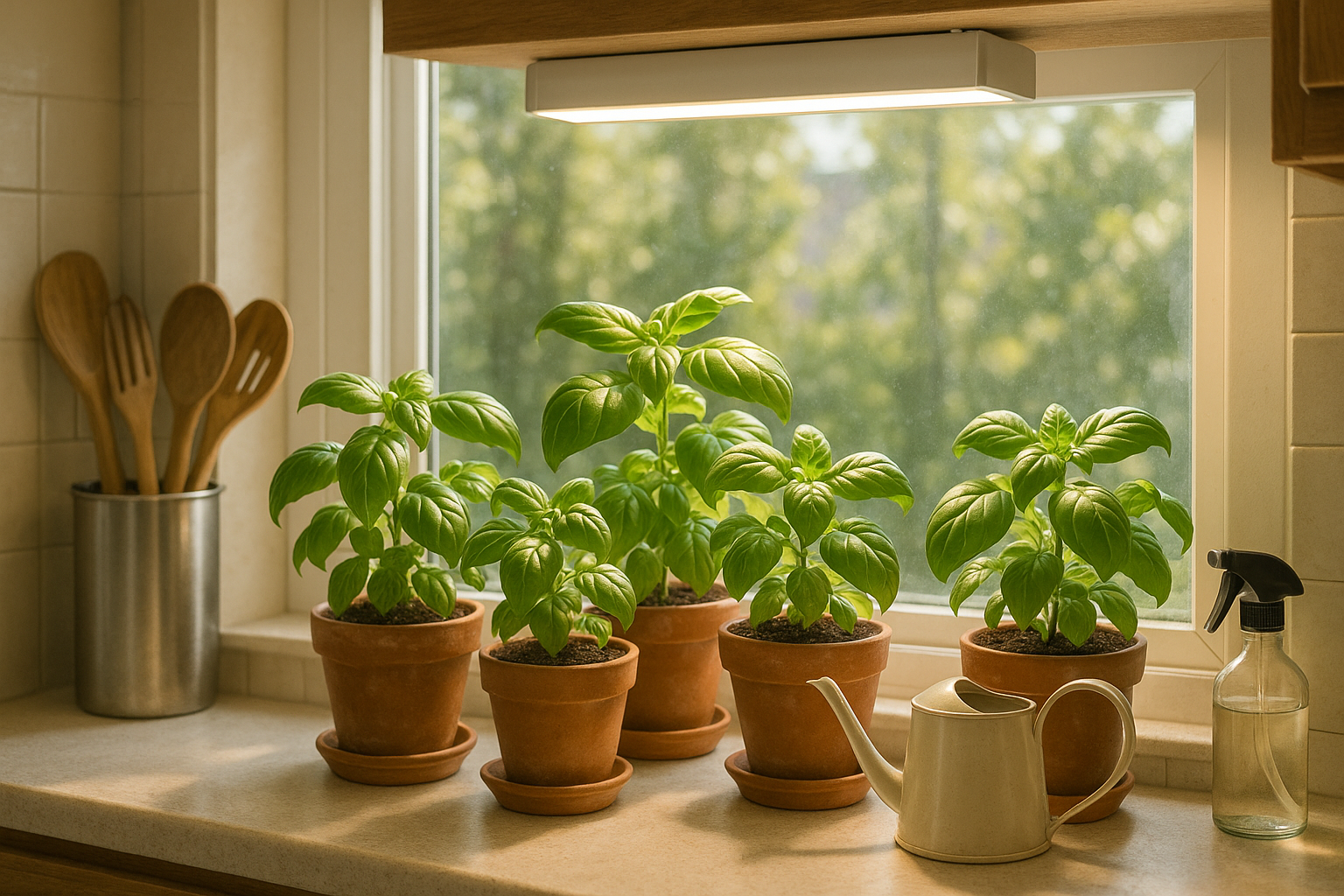Why Grow Basil Indoors?
Growing basil indoors offers numerous benefits beyond just having a decorative plant on your windowsill. First, fresh basil is always within reach, allowing you to add flavor to your dishes year-round without worrying about store availability or wilted leaves.
Indoor basil plants thrive in pots or small containers, making them perfect for apartments and homes with limited space. You don’t need a large backyard—just a sunny south-facing window or a simple grow light can keep your basil lush and healthy.
Plus, keeping your basil indoors helps you avoid common outdoor pests that can harm your harvest and reduces the need for chemical sprays. Basil adapts quickly to changes in lighting and prefers the warm, stable temperatures found in most homes, making it especially well-suited for indoor environments.
Another bonus: basil leaves naturally release a pleasant scent, and their air-purifying qualities can help improve your indoor environment by absorbing some toxins.
Worried about space or sunlight? Basil only requires 6-8 hours of indirect sunlight, which can easily be provided by inexpensive LED grow lights if natural light is limited. Even in the smallest kitchen, you can enjoy fresh, flavorful basil year-round with just a little care and creativity.
Essential Supplies for Indoor Basil Growing
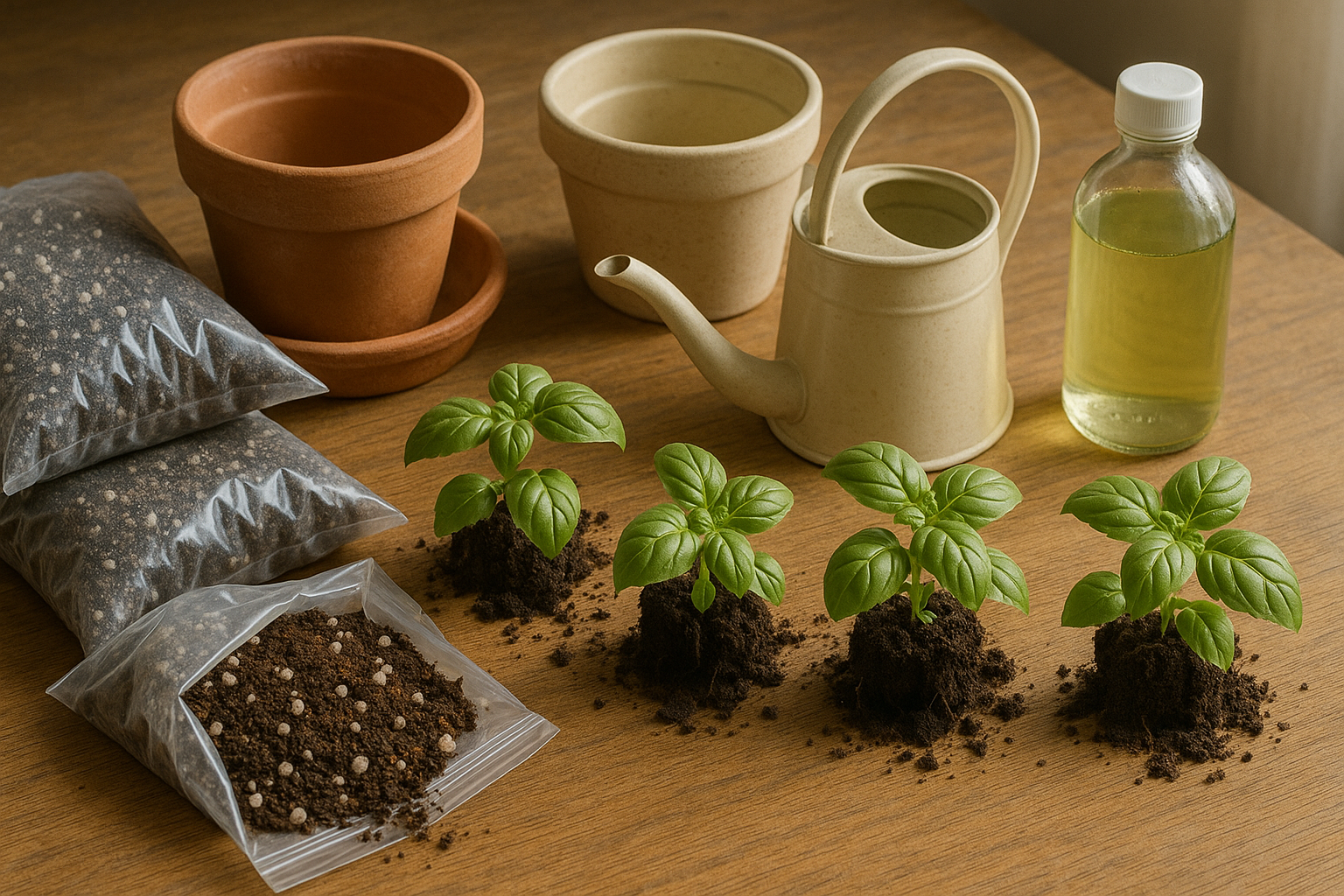
For a thriving indoor basil garden, start with pots or containers that have drainage holes at the bottom—this is non-negotiable, as basil roots hate sitting in waterlogged soil. Look for pots that are at least six inches wide and deep; terra cotta and ceramic options are excellent for airflow, while lightweight plastic pots are great if you need to move them to catch more sunlight.
Next, choose a premium potting mix rather than garden soil, which can compact and limit drainage. Opt for soil labeled “well-draining” that ideally includes ingredients like perlite or coconut coir to help roots breathe.
Whether you’re working with seeds or baby starter plants from a garden center, both can yield bountiful basil, though beginners might find starter plants to be a quicker route to fragrant leaves.
Don’t forget an all-purpose liquid fertilizer—aim to feed your basil twice a month, but dilute it to half-strength to avoid overwhelming delicate roots.
Placement is just as important as your supplies. Set your basil in a bright, sunny spot—southern or eastern windows are best, offering at least six hours of light daily. If natural light is scarce, a small grow light can make all the difference.
Consistent warmth, good light, breathable soil, and drainage-friendly pots are the essentials, transforming your kitchen windowsill into a basil oasis perfect for snipping fresh leaves all season long.
Step-by-Step Guide to Planting Basil Indoors
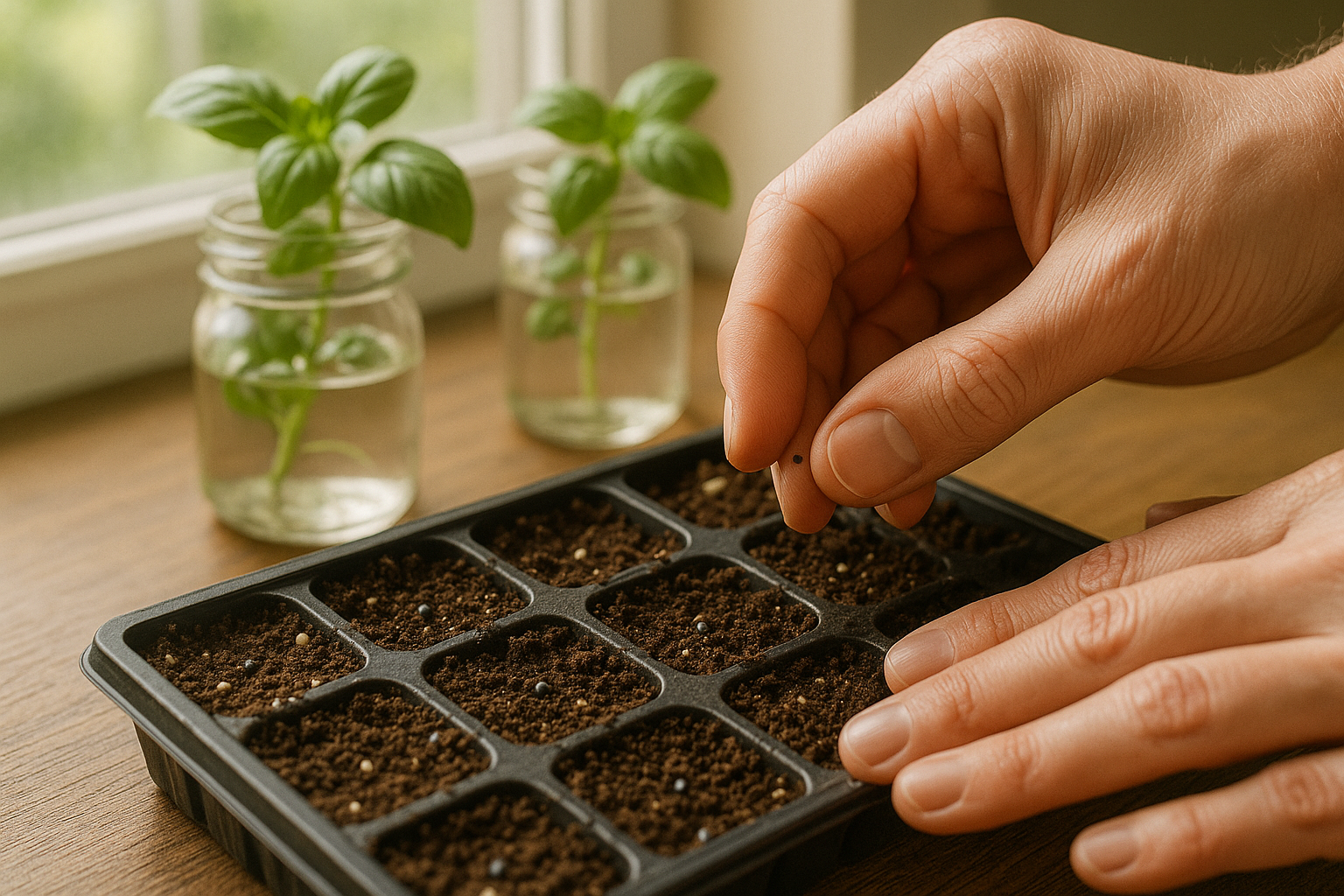
Planting basil indoors is easy and rewarding, whether you choose to start from seeds or propagate from cuttings. Growing from seeds is often more cost-effective and allows you to try different varieties. Simply pick up a packet of seeds and start them indoors any time of year—though many gardeners prefer spring for optimal natural light.
To grow from seeds, fill a small container or tray with quality seed-starting mix, lightly moisten the soil, then scatter basil seeds on top. Press them gently into the surface or cover with a very thin layer of mix (about ¼ inch deep), as basil seeds need some light to germinate. Keep the soil consistently moist and warm (70–75°F), and you’ll see sprouts in about a week.
If you have access to a healthy basil plant, you can also propagate by cuttings. Snip a 4-inch stem just below a leaf node, remove the lower leaves, and place the cutting in water until roots develop (about 5–10 days). Once rooted, pot it up in moist potting mix.
Whether sowing seeds or planting cuttings, use containers with drainage holes and space plants 6–8 inches apart for airflow, which helps prevent fungal problems.
If you’re growing multiple basil varieties—like Genovese, Thai, or Purple—label each container with the variety name and sowing date. This avoids mix-ups and helps you track growth rates.
Place your basil plants in a sunny windowsill or under grow lights for at least 6 hours of light daily. With just a bit of care and the right setup, you can enjoy fresh basil leaves at your fingertips all year round, elevating any homemade meal.
Caring for Your Indoor Basil Plant
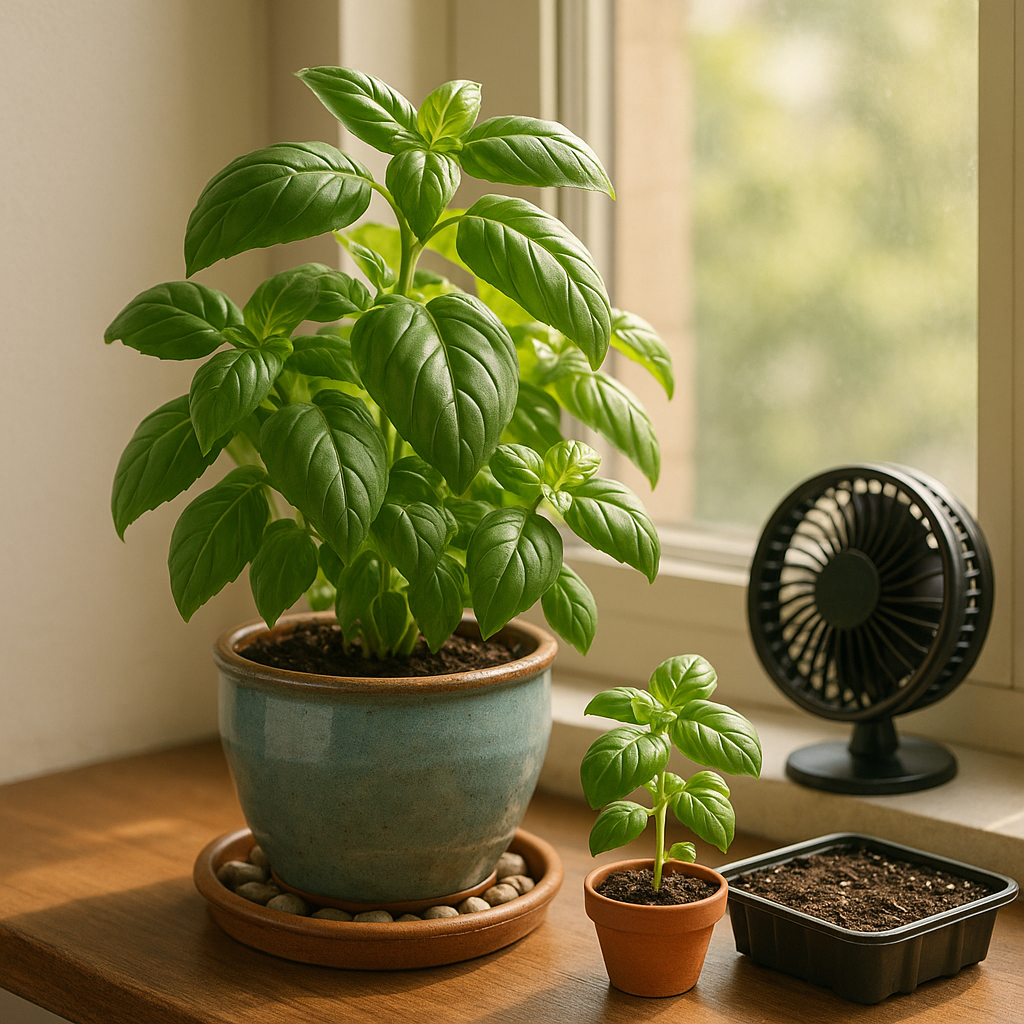
Keeping your indoor basil plant healthy starts with good watering habits—basil likes its soil to be moist but never soggy. As a rule, water your basil when the top inch of soil feels dry to the touch; just stick your finger in to check. If the leaves begin to droop or wilt, your plant probably needs a drink. However, if the leaves turn yellow or the soil stays wet for days, that’s a sign you’re watering too much. Always use pots with drainage holes to avoid waterlogged roots.
For sunlight, basil thrives with at least 6 hours of direct light daily. Place it in a south- or west-facing window for the best results, or supplement with an LED grow light if your home doesn’t get enough natural sun, especially during the winter months.
Fertilize indoor basil every 4–6 weeks with a balanced, water-soluble fertilizer at half strength to keep new leaves lush without overwhelming the plant or altering its flavor.
Basil prefers temperatures between 70–80°F (21–27°C) during the day and above 50°F (10°C) at night, so keep it away from drafty windows or heating vents. Good air circulation is vital for strong, healthy growth and preventing mold—use a small fan or simply crack a window open occasionally.
Finally, basil appreciates a bit of humidity but generally adapts well to typical indoor levels. If the air in your home is dry, mist the leaves or set the pot on a tray filled with pebbles and water (making sure the pot itself isn’t sitting in the water) to create a mini humidity boost.
With these simple care tips, your basil should remain vibrant and productive all year long.
Harvesting Basil & Troubleshooting Common Issues
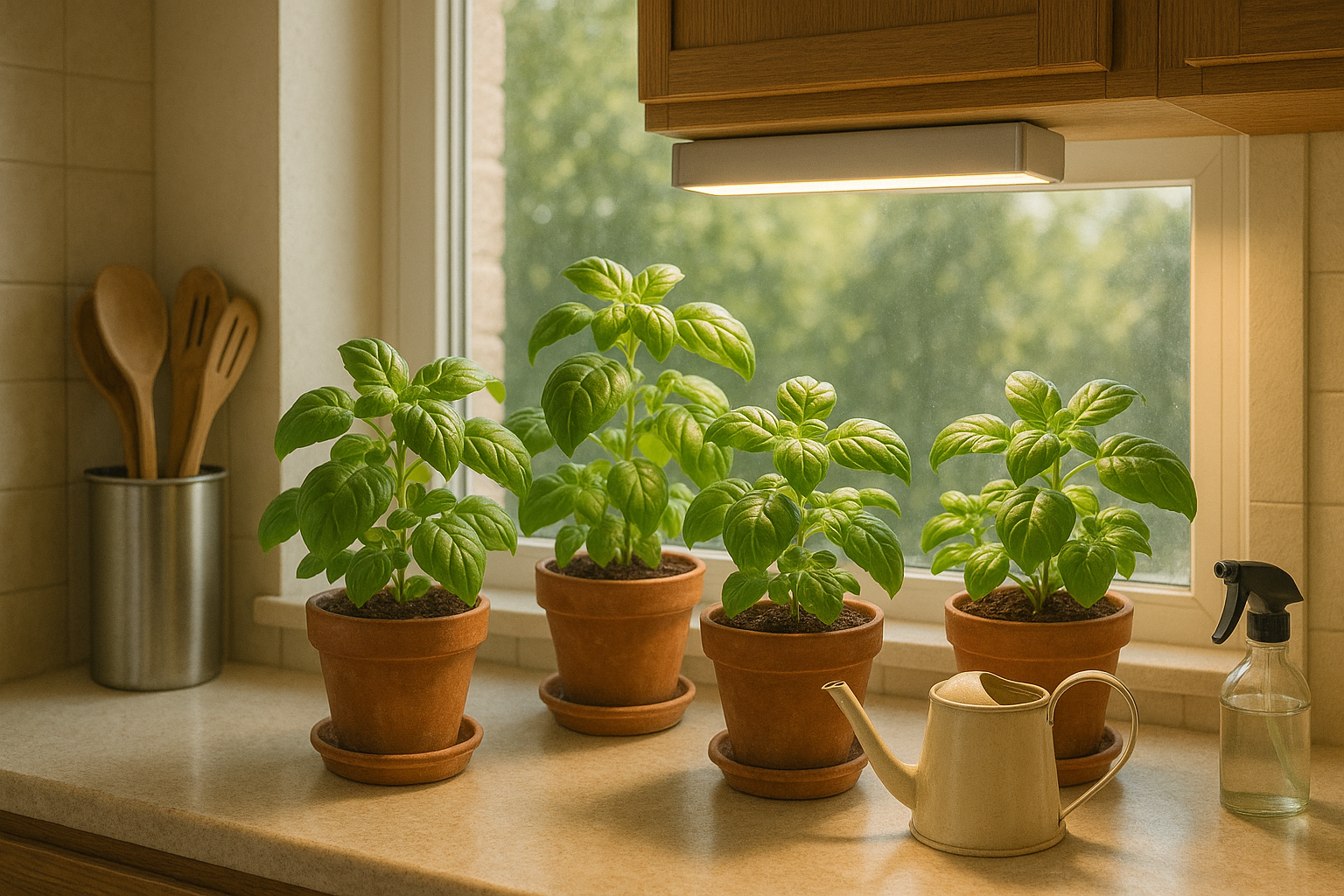
Harvesting basil at the right time ensures both a plentiful supply for your kitchen and a healthy, thriving plant. The best time to harvest is when the basil has at least six sets of leaves and stands about six to eight inches tall. Pinch or snip just above a pair of leaves, ideally in the morning when the plant’s essential oils are most potent.
Regularly trimming basil encourages bushier growth and prevents the plant from becoming leggy. Be careful not to remove more than one-third of the plant at once, as this can stress it and slow regrowth.
Common Issues and How to Fix Them
A common issue you may notice with your basil is “bolting,” which is when the plant starts to flower and shifts its energy from leaf production to generating seeds. Bolting often happens in hot weather, so to delay it, regularly pinch off flower stems as soon as they appear and provide light afternoon shade if possible.
Other issues to watch for include:
- Yellow leaves: This can signal overwatering, nutrient deficiencies, or lack of sunlight. Adjust your watering schedule, feed with a balanced fertilizer, and move your plant to a sunnier spot if needed.
- Pests: Basil may attract aphids or spider mites. Combat them with a strong spray of water or insecticidal soap.
- Poor growth: Check that the plant isn’t rootbound if it’s in a pot, and ensure it has rich, well-draining soil.
With consistent harvesting and some attentive care, your basil can thrive all season long.
Quick Ideas to Use Your Homegrown Basil
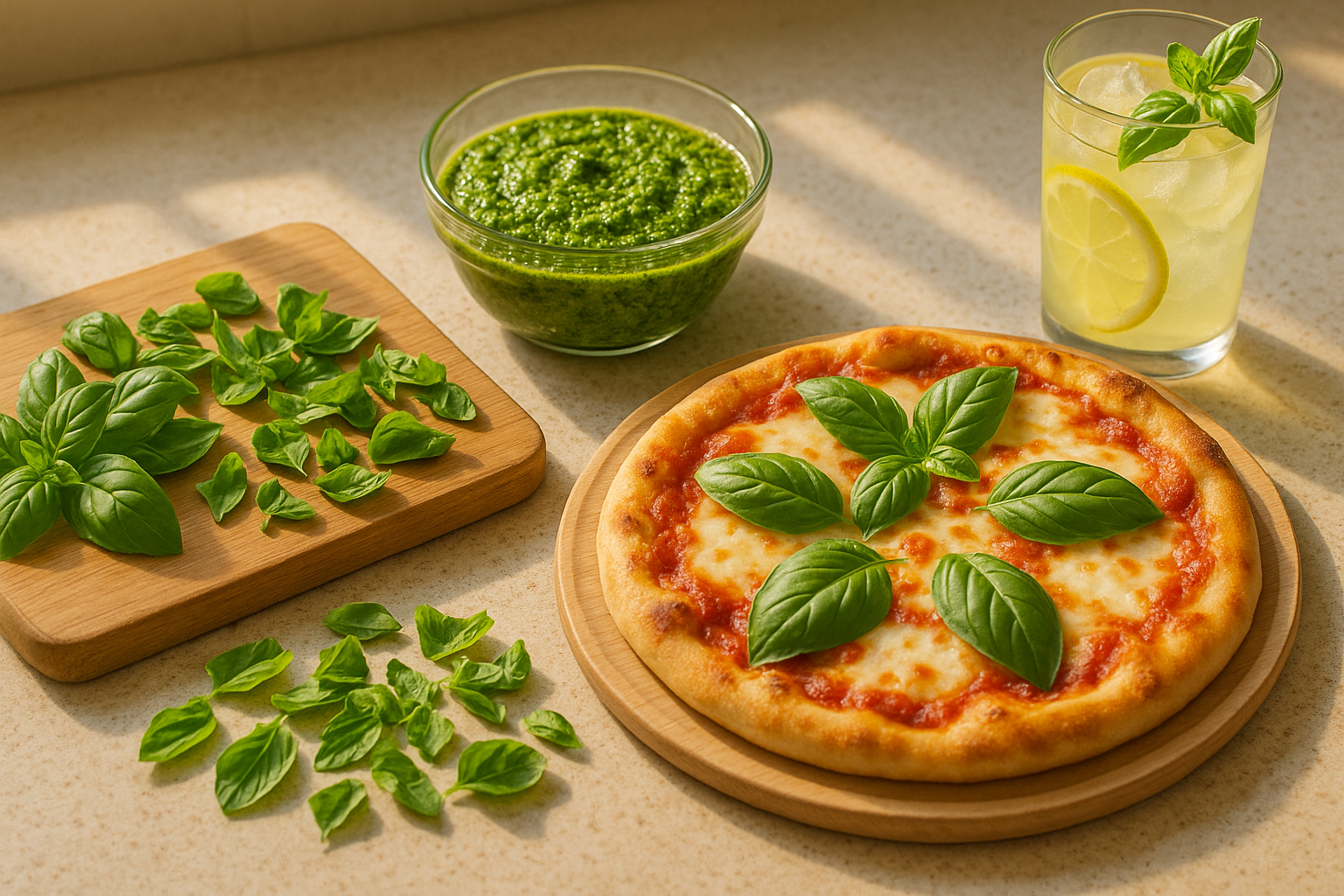
Freshly harvested basil is a treasure waiting to be enjoyed in countless ways. For an easy burst of flavor, toss torn basil leaves over pasta, pizza, or salads—the herb’s aroma instantly lifts any dish.
Make a quick pesto by blending basil with garlic, olive oil, nuts, and Parmesan, or stir chopped basil into scrambled eggs and soups for a fresh twist. Basil also makes a refreshing addition to drinks: infuse water, lemonade, or cocktails with a handful of leaves for a subtle, herbal note.
Don’t forget about simple garnishes—just a sprig of basil can transform the look and taste of grilled veggies, bruschetta, or even ice cream.
If you find yourself with more basil than you can use, preserve its flavor by:
- Freezing whole leaves in olive oil using ice cube trays
- Spreading leaves on a tray to freeze individually before transferring them to airtight bags
- Drying basil in a low-temperature oven or hanging it upside down in small bunches; once dry, crumble it into jars for year-round use
Consider experimenting with different basil varieties like Thai, lemon, or purple basil to unlock new flavors in curries, teas, or salads—the possibilities are endless when you grow your own.
